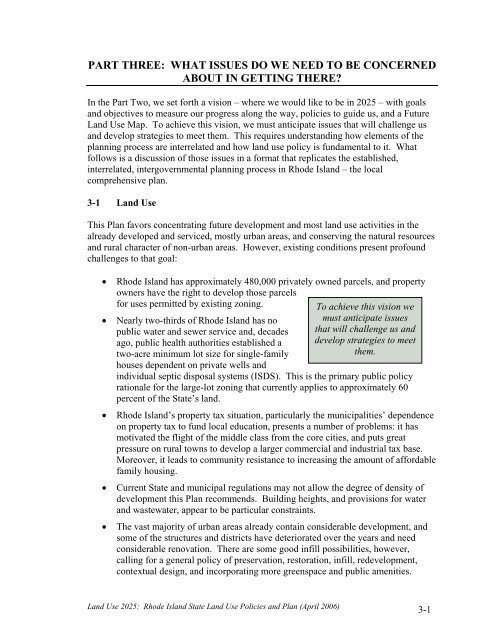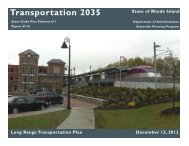Land Use 2025 - RhodeMap RI
Land Use 2025 - RhodeMap RI
Land Use 2025 - RhodeMap RI
- No tags were found...
Create successful ePaper yourself
Turn your PDF publications into a flip-book with our unique Google optimized e-Paper software.
PART THREE: WHAT ISSUES DO WE NEED TO BE CONCERNEDABOUT IN GETTING THERE?In the Part Two, we set forth a vision – where we would like to be in <strong>2025</strong> – with goalsand objectives to measure our progress along the way, policies to guide us, and a Future<strong>Land</strong> <strong>Use</strong> Map. To achieve this vision, we must anticipate issues that will challenge usand develop strategies to meet them. This requires understanding how elements of theplanning process are interrelated and how land use policy is fundamental to it. Whatfollows is a discussion of those issues in a format that replicates the established,interrelated, intergovernmental planning process in Rhode Island – the localcomprehensive plan.3-1 <strong>Land</strong> <strong>Use</strong>This Plan favors concentrating future development and most land use activities in thealready developed and serviced, mostly urban areas, and conserving the natural resourcesand rural character of non-urban areas. However, existing conditions present profoundchallenges to that goal:• Rhode Island has approximately 480,000 privately owned parcels, and propertyowners have the right to develop those parcelsfor uses permitted by existing zoning.• Nearly two-thirds of Rhode Island has nopublic water and sewer service and, decadesago, public health authorities established atwo-acre minimum lot size for single-familyhouses dependent on private wells andTo achieve this vision wemust anticipate issuesthat will challenge us anddevelop strategies to meetthem.individual septic disposal systems (ISDS). This is the primary public policyrationale for the large-lot zoning that currently applies to approximately 60percent of the State’s land.• Rhode Island’s property tax situation, particularly the municipalities’ dependenceon property tax to fund local education, presents a number of problems: it hasmotivated the flight of the middle class from the core cities, and puts greatpressure on rural towns to develop a larger commercial and industrial tax base.Moreover, it leads to community resistance to increasing the amount of affordablefamily housing.• Current State and municipal regulations may not allow the degree of density ofdevelopment this Plan recommends. Building heights, and provisions for waterand wastewater, appear to be particular constraints.• The vast majority of urban areas already contain considerable development, andsome of the structures and districts have deteriorated over the years and needconsiderable renovation. There are some good infill possibilities, however,calling for a general policy of preservation, restoration, infill, redevelopment,contextual design, and incorporating more greenspace and public amenities.<strong>Land</strong> <strong>Use</strong> <strong>2025</strong>: Rhode Island State <strong>Land</strong> <strong>Use</strong> Policies and Plan (April 2006) 3-1
















